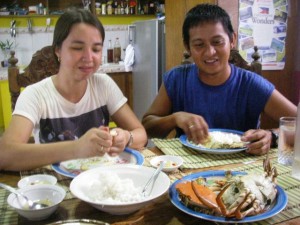 Rice farming was the main agricultural activity in Hagony, a Philippines coastal community, at least up to the 1980s. It was around that time that the salinity of the water started to rise; eventually to levels unacceptable for growing rice. Many believe the salinity increase stems from drainage canals and dikes built in the 1970s by neighbouring provinces, to stem seasonal flooding. Those same canals dried up at other times of the year, allowing sea water to penetrate inland, and eventually intrude into the underground aquifers in a neighbouring region; i.e., Hagonoy. And so while one region benefits from flood control, Hagonoy must deal with the unintended consequences land unsuitable for rice farming. What follows is a story of how one farming family adapts.
Rice farming was the main agricultural activity in Hagony, a Philippines coastal community, at least up to the 1980s. It was around that time that the salinity of the water started to rise; eventually to levels unacceptable for growing rice. Many believe the salinity increase stems from drainage canals and dikes built in the 1970s by neighbouring provinces, to stem seasonal flooding. Those same canals dried up at other times of the year, allowing sea water to penetrate inland, and eventually intrude into the underground aquifers in a neighbouring region; i.e., Hagonoy. And so while one region benefits from flood control, Hagonoy must deal with the unintended consequences land unsuitable for rice farming. What follows is a story of how one farming family adapts.
I’m in Hagonoy, with the Canadian Executive Service Organization (CESO), working as a Volunteer Advisor to the e-Governance for Municipal Development (eGov4MD) project. The eGov4MD project is an international collaborative, orchestrated by the League of Municipalities of the Philippines (LMP), bringing together various Filipino organizations, municipalities, and foreign nonprofits (e.g., CESO).
It is through the eGov4MD project that I met Lizzie Fajardo. She and her husband Chris Fajardo own a local farm. Last weekend, I spent some time with them, and some of their family and friends. In the process, I got to know a little bit more about them, their situation, lucked into some awesome home cooking, and gained new respect for the potential of videoke!
Adapting to the situation
Hagonoy is a municipality of about 130,000 people, located across the bay from Manila, the Philippines mega-city of 15 million people. Hagonoy is 70% water or wetlands, 30% dry land. The wealth of the Municipality does not include financial resources. There are many poor people.
The Fajardos live in a barangay (neighbourhood) of Hagonoy. They have a saltwater-based fish farming business, managed by Chris. The farm is 5 hectares in size. Current fish volumes are 150,000 prawns, 5,000 crab, and 2300 milk fish; distributed across 2 ponds. Fish are purchased from hatcheries (e.g., prawns from San Felipe). All fish co-exist in the same space, and all are harvested every 4 months, with some breaks in-between. Twenty years earlier, where there are now fish ponds, there were rice fields. Both Lizzie and Chris have extended family living on adjacent properties, and who assist in their farm operation.
Lizzie helps on the farm on the weekends. During the week she acts as a charge d’affaires (as I understand her role anyways!) for the Mayor. Her position is co-terminus with that of the Mayor. It was a big day on the fish farm when I visited them, as they were harvesting milk fish (note: they also grow many vegetables, including kasaba and grean beans, and tap olive oil from local plants). Unfortunately, the weather delayed my arrival until the harvest was just wrapping up! Later in the day, the catch would be taken to the local (export) market. This short video contains tidbits of my tricycle trip to their place, and at their farm.
After a splendid lunch of farm-fresh king crab, prepared by Lizzie, I talked with Lizzie and Chris about their work. We were joined by Ellen Manalo, who also works for the Municipal Mayor’s Office, as point person for citizens in need (e.g., of emergency health services). Her family also owns a farm, growing rice and corn. The conversation touched on agriculture and fishing practices, farm economics, role of government… Here’s part of our conversation…
Everything is connected
The challenges in Hagonoy are systemic. Everything is connected. Neighbouring provinces make decisions without sufficient dialogue and analysis. Dikes lead to intrusion of saltwater into once fertile agricultural lands, leaving farmers with little choice beyond converting from rice to fish farming. Along with the sea water comes the toxicity of Manila Bay (in many ways a sewer for metro Manila). Even with good water/fishing management practices, the life/quality of fish farmed is impacted, along with fish marketability. And then there is the consumer implication for all of this!
Whatever the long-term future of Hagonoy holds, I suspect the Municipality will find ways to improve and/or mitigate their situation. And that creative, collaborative partnership will continue to be needed, and part of how the Municipality moves forward in positive ways.
What’s your workplace experience – of living with unintended consequences?

Speak Your Mind